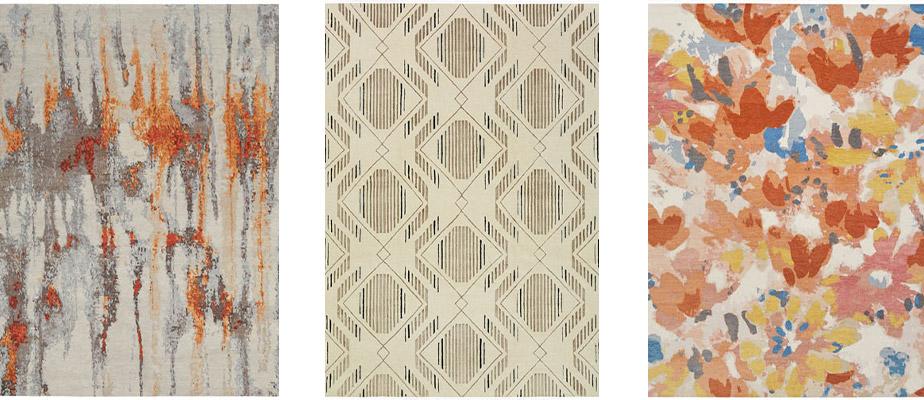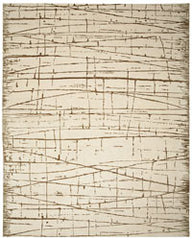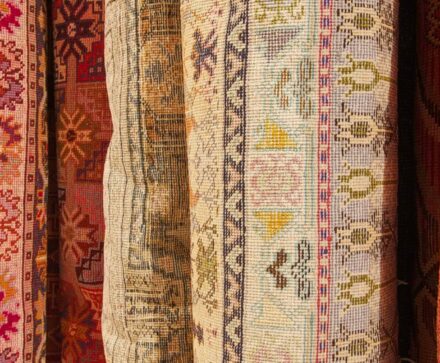Tibetan Rugs: What You Need to Know

Tibetan rugs are unique and made in a way that no other rug is made. Learn more about what Tibetan rugs are and how to display them from Sam Presnell, owner of The Rug Gallery.
LISTEN NOW
John Maher: Welcome to the Rug Gallery with Sam Presnell. The Rug Gallery is an Oriental rug company and carpet store in Cincinnati, Ohio. I’m John Maher, I’m here with the owner of the Rug Gallery Sam Presnell. Hi Sam.
Sam Presnell: Hi John.
How Tibetan Rugs Are Made
John: So Sam today we’re talking about Tibetan rugs. So, what type of unique wool are Tibetan rugs made from?

Sam: I think that’s the key to Tibetan rugs [that] will make them different any other rug in the world – it’s the wool. You can imagine being from the Tibetan plateau, is a very cold climate and those sheep have been bred for thousands of years for their wool. They are basically have very hardy, sturdy, well made wool with a lot of lanolin and also very long staple, which means they [have] long lengths. So when you’re shearing a sheep, you want those long lengths, because when you shear something you can spin it much tighter when you got those long lengths.
We call that long staple and a lot of times you see cheaper rugs they usually use short fibers called short staples but the Tibetan rugs, the wool is the key and its all because of the climate where they’re from and the breeding that they’ve done over the centuries.
Tibetan wool
John: So, why is this type of wool used in Tibetan rugs versus other types of wool, and what does it create in terms of the way that the rugs feels or looks?
Sam: It’s the finish. You get a very nice velvet feel to it and a really nice sharp silky appearance to it when you wash it properly, that really no other wool rug in the world can achieve. Unless, you’ve got something that I call a Kirk wool, which would be a belly side of a lamb or underneath the neck side of a lamb.

There’s just something about the wool that is very cool, but the big thing is that you cannot take Tibetan wool any place else in the world and weave it. You can only do it in Nepal and in Tibet. So, they’re not exporting that wool to say the rest of India, or Pakistan, or China, or wherever. They’re weaving it in those areas and basically it’s done by the either the Tibetans themselves from China or the Tibetan refugees in Nepal.
John: So, if you’re getting a Tibetan rug, then you’re getting a rug that was made there in Tibet, is that right?
Sam: Yes, I wouldn’t say 100% but as a whole, yes.
How to Use Tibetan Rugs In Your Home
John: So, can Tibetan rugs be used also in your home for just more than floor coverings? How else can someone display a Tibetan rug in their home?
Sam: Yes, I actually do [have one.] I have one on my walls as well because it’s a dragon carpet, and I think it just came off so cool as a textile. And you could definitely use it as a wall piece. I’ll say that’s very unusual to see that in most homes. Most Tibetan rugs are very thick, very heavy rugs, so they would probably do better as a floor covering.
John: Okay. Any final thoughts on Tibetan rugs and why somebody would want to consider purchasing a Tibetan rug for their home?

Sam: I’m an emotional person in so many ways and the Tibetan people are such beautiful people. I don’t think we’re more blessed than to deal with the Tibetan in the way that they look at life and the way they treat people. They are not people who are going to harm you, they are not people who are going to hurt you, if they can help you they will, but they surely not going to harm you in any way. They are the sweetest, nicest people that you can imagine and you definitely, your heart goes out to them and they have a very simple way of living. They may be very poor but they’re very happy. They’re just a real pleasure to be around. So, I love to support [them] every chance I get just because I really appreciate them as just really solid great people.
John: That’s great and a great reason to go ahead and invest in a Tibetan rug for your home.
Sam: Most definitely, that’s one of the main things for my opinion.
John: All right, well thanks for speaking to me about the Tibetan rugs Sam.
Sam: All right John, my pleasure you know that.
John: For more information about Sam, the Rug Gallery and oriental rugs and carpets, visit [therugallery.com]or call 513-793-9505. Make sure you catch the latest episode of this broadcast by subscribing on iTunes, and if you can take the time please give us a review on iTunes as well. See you next time on the Rug Gallery.
What makes Tibetan rugs unique?
There is so much to love about the Tibetan people and their culture. Since their culture is a very spiritual one, they are people with big, helpful hearts. When you meet Tibetans, they go out of their way to help you and do everything in their power to make your visit a comfortable one. They bring you, the visitor, gifts. And they make you feel like family.
When Mao and the communist government of China invaded Tibet, many Tibetans fled to Nepal. Because of this and the Chinese restrictions on the Tibetans, the rugs we refer to as Tibetan are actually woven in Nepal. They have not lost the feel or reflection of their amazing culture, though.
1. Tibetan sheep
Tibetan rugs have a unique look. A lot of the credit for this goes to the Tibetan sheep. Their wool is among the best in the world. Extreme cold and other environmental factors have led to genetic improvements in the wool, making it denser and longer than other sheep wool. These attributes give Tibetan rugs a greatly improved performance and a genuinely gorgeous finish.
2. Spinning wool
Tibetan wool is hand spun. This is an art form unto itself. When wool is hand spun, there are variations in thickness. The tighter the spin, the thinner the strand of yarn. These irregularities are very desirable; the yarn accepts dye in differing densities, thus giving the yarn the variations in color that give it depth and character.
At this point in the process, modern technology comes into play. Designs are done on CAD/CAM machines, which allow designs and colors to be changed quickly. This is the only part of the process that has been modernized. The actual loom drawings, from which the weavers work, are all still painted by hand. Each square on the grid is one knot.
2. Dye masters
Dye masters are revered in Tibetan culture. Their expertise insures the accuracy of dying, which in turn insures the consistency of color needed.
3. Weaving technique
Tibetan weaving is totally unique from other Oriental weaving styles. The knots are wrapped around a rod before being sheared. The weft goes over the top of the knots, which are then pounded into place, which holds the rug together. These steps are repeated over and over until the rug is completed.
Once the rug is completed, it is washed. This is where the finish is honed. Washing produces the shine and velvet-like finish we love to see and touch.
Video Library
Learn a little more about Tibetan rugs with these selections from our video library.
Transcript
Tibetan rugs. I think it’s kind of interesting that people think that it’s all the rugs that come from Tibet. Actually, it can be, but the vast majority of Tibetan rugs are made in Nepal and usually made by the Tibetan refugees or else the companies that own the rug producers are Tibetan. A lot of their technique as far as their weaving which makes them different is they use a rod system which they tie the knot around which is very unique and really speeds up the process of making a rug. Also what’s really cool about the Tibetan rugs is the wool. Now, they do get their wool from Tibet, which it’s an indigenous sheep that has been bred for hundreds and hundreds of years, basically, for its wool coat. Basically, you have an extremely fine wool with long staple.
There’s something about a Tibetan rug when you look at the finish of it, how soft and how smooth, and it has a silkiness to it even though it’s wool, that no other – I don’t think any silk wool in the world has that type of look. There’s a few that simulate it, but the Tibetans consistently make the best wool and that’s what makes them different than any other rug that kind of looks like a Tibetan rug that is made in another country.
Also, what’s nice about the Tibetan rugs is you get a combination of wool and silk. You can get 100% wool. They have different thicknesses and different densities that they weave at so that can also affect the price, but you’re also seeing a lot of rugs that look like Tibetan rugs, being called Tibetan, but they’re made in other countries like India. So we see a lot of – even though they’re called Tibetan, we call them Indo-Tibetan. They’re not, in my words, the exact same thing as a Tibetan rug. But very cool rugs, they can do a lot of different things with Tibetan rugs, they can be very modern, they can be very traditional, transitional. They can just do texture. It’s really just a beautiful product and also beautiful people that make the product as well.
Tibetan Rugs from The Rug Gallery
For us, the advantage of weaving in Nepal is the ability to design and make one rug at a time. We can change any color or size for a customer’s needs. Each Tibetan rug that is made for one of our customers is truly unique, a rug made just for them and no one else. Normal weaving time is 3 – 4 months, with no extra cost for any of the customization.
Made using the same materials and techniques used for centuries, this is truly a green product.




